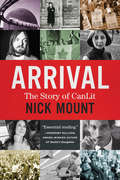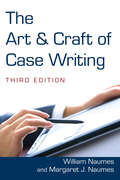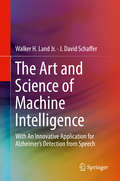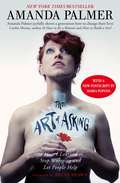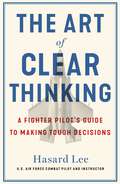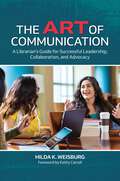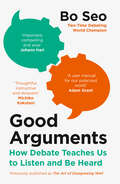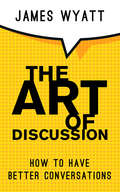- Table View
- List View
Array Signal Processing (Signal Processing and Digital Filtering)
by S. Unnikrishna PillaiThis book is intended as an introduction to array signal process ing, where the principal objectives are to make use of the available multiple sensor information in an efficient manner to detect and possi bly estimate the signals and their parameters present in the scene. The advantages of using an array in place of a single receiver have extended its applicability into many fields including radar, sonar, com munications, astronomy, seismology and ultrasonics. The primary emphasis here is to focus on the detection problem and the estimation problem from a signal processing viewpoint. Most of the contents are derived from readily available sources in the literature, although a cer tain amount of original material has been included. This book can be used both as a graduate textbook and as a reference book for engineers and researchers. The material presented here can be readily understood by readers having a back ground in basic probability theory and stochastic processes. A prelim inary course in detection and estimation theory, though not essential, may make the reading easy. In fact this book can be used in a one semester course following probability theory and stochastic processes.
Arrival: The Story of CanLit
by Nick Mount“The most important book to be written in more than 40 years about the rise of Canadian literature… Arrival: The Story of CanLit brims and crackles, in equal measure, with information and energy.” — Winnipeg Free PressA Globe and Mail Top 100 BookNational Post 99 Best Books of the YearIn the mid-twentieth century, Canadian literature transformed from a largely ignored trickle of books into an enormous cultural phenomenon that produced Margaret Atwood, Alice Munro, Michael Ondaatje, Mordecai Richler, and so many others. In Arrival, acclaimed writer and critic Nick Mount answers the question: What caused the CanLit Boom?Written with wit and panache, Arrival tells the story of Canada’s literary awakening. Interwoven with Mount’s vivid tale are enlightening mini-biographies of the people who made it happen, from superstars Leonard Cohen and Marie-Claire Blais to lesser-known lights like the troubled and impassioned Harold Sonny Ladoo. The full range of Canada’s literary boom is here: the underground exploits of the blew ointment and Tish gangs; revolutionary critical forays by highbrow academics; the blunt-force trauma of our plain-spoken backwoods poetry; and the urgent political writing that erupted from the turmoil in Quebec.Originally published to coincide with the 150th anniversary of Canadian Confederation, Arrival is a dazzling, variegated, and inspired piece of writing that helps explain how we got from there to here.
Art and Activism in the Age of Systemic Crisis: Aesthetic Resilience (Routledge Research in Art and Politics)
by Eliza Steinbock Bram Ieven Marijke De ValckThis book examines how renewed forms of artistic activism were developed in the wake of the neoliberal repression since the 1980s. The volume shows the diverse ways in which artists have sought to confront systemic crises around the globe, searching for new and enduring forms of building communities and reimagining the political horizon. The authors engage in a dialogue with these artistic efforts and their histories – in particular the earlier artistic activism that was developed during the civil rights era in the 1960s and 70s – providing valuable historical insight and new conceptual reflection on the future of aesthetic resilience. This book will be of interest to scholars in contemporary art, history of art, film and literary studies, protest movements, and social movements.
Art and Activism in the Age of Systemic Crisis: Aesthetic Resilience (Routledge Research in Art and Politics)
by Eliza Steinbock Bram Ieven Marijke De ValckThis book examines how renewed forms of artistic activism were developed in the wake of the neoliberal repression since the 1980s. The volume shows the diverse ways in which artists have sought to confront systemic crises around the globe, searching for new and enduring forms of building communities and reimagining the political horizon. The authors engage in a dialogue with these artistic efforts and their histories – in particular the earlier artistic activism that was developed during the civil rights era in the 1960s and 70s – providing valuable historical insight and new conceptual reflection on the future of aesthetic resilience. This book will be of interest to scholars in contemporary art, history of art, film and literary studies, protest movements, and social movements.
The Art and Craft of Case Writing
by William Naumes Margaret J. NaumesFilled with helpful checklists, charts, and suggestions for further reading, this practical, comprehensive, and multidisciplinary guide takes readers through the entire case-writing process, including skills for writing both teaching cases and research cases. This edition includes new discussions of students as case writers, and how to interpret and respond to reviews, as well as updated and expanded material on video, multimedia and Internet cases.
The Art and Craft of Case Writing
by William Naumes Margaret J. NaumesFilled with helpful checklists, charts, and suggestions for further reading, this practical, comprehensive, and multidisciplinary guide takes readers through the entire case-writing process, including skills for writing both teaching cases and research cases. This edition includes new discussions of students as case writers, and how to interpret and respond to reviews, as well as updated and expanded material on video, multimedia and Internet cases.
The Art and Science of Communication: Tools for Effective Communication in the Workplace
by P. S. PerkinsThe Art and Science of Communication shows you a new way to understand and use communication in the workplace. Revealing the seven types of communication we all use every day, the book shows you how to increase your communication effectiveness in any setting with practical techniques, analogies, and models that clearly explain the formulas for successful communication. Combining the science and art of communication into one effective formula, this book offers a straightforward and easy to understand plan for a more successful career.
The Art and Science of Expert Witness Testimony: A Multidisciplinary Guide for Professionals
by Karen PostalFeaturing in-depth interviews of attorneys, judges, and seasoned forensic experts from multiple disciplines including psychology, medicine, economics, history, and neuropsychology, The Art and Science of Expert Witness Testimony highlights and offers bridges for the areas where the needs and expectations of the courtroom collide with experts’ communication habits developed over years of academic and professional training. Rather than seeing testimony as a one-way download from expert to jurors, The Art and Science of Expert Witness Testimony focuses on the direct, dynamic, unique communication relationship that develops as each juror’s lived experience interacts with the words of experts on the stand. This book expands the academic tradition of "methods-centered credibility" to also include "person-centered credibility," where warmth, confidence, and relentless attention to detail build trust with jurors. Seasoned forensic experts share what they actually say on the stand: their best strategies and techniques for disrupting traditional academic communication and creating access to science and professional opinions with vivid, clear language and strong visuals. The difficult but necessary emotional work of the courtroom is addressed with specific techniques to regulate emotions in order to maintain person-centered credibility and keep the needs of jurors front and center through cross-examination. This innovative compilation of research is essential reading for professionals and practitioners, such as physicians, engineers, accountants, and scientists, that may find themselves experts in a courtroom. The Art and Science of Expert Witness Testimony provides a unique experience for readers, akin to being personally mentored by over eighty-five attorneys, judges, and seasoned experts as they share their observations, insights, and strategies—not to "win" as a defense, prosecution, or plaintiff expert, but to be productive in helping jurors and other triers of fact do their difficult intellectual job in deciding a case.
The Art and Science of Expert Witness Testimony: A Multidisciplinary Guide for Professionals
by Karen PostalFeaturing in-depth interviews of attorneys, judges, and seasoned forensic experts from multiple disciplines including psychology, medicine, economics, history, and neuropsychology, The Art and Science of Expert Witness Testimony highlights and offers bridges for the areas where the needs and expectations of the courtroom collide with experts’ communication habits developed over years of academic and professional training. Rather than seeing testimony as a one-way download from expert to jurors, The Art and Science of Expert Witness Testimony focuses on the direct, dynamic, unique communication relationship that develops as each juror’s lived experience interacts with the words of experts on the stand. This book expands the academic tradition of "methods-centered credibility" to also include "person-centered credibility," where warmth, confidence, and relentless attention to detail build trust with jurors. Seasoned forensic experts share what they actually say on the stand: their best strategies and techniques for disrupting traditional academic communication and creating access to science and professional opinions with vivid, clear language and strong visuals. The difficult but necessary emotional work of the courtroom is addressed with specific techniques to regulate emotions in order to maintain person-centered credibility and keep the needs of jurors front and center through cross-examination. This innovative compilation of research is essential reading for professionals and practitioners, such as physicians, engineers, accountants, and scientists, that may find themselves experts in a courtroom. The Art and Science of Expert Witness Testimony provides a unique experience for readers, akin to being personally mentored by over eighty-five attorneys, judges, and seasoned experts as they share their observations, insights, and strategies—not to "win" as a defense, prosecution, or plaintiff expert, but to be productive in helping jurors and other triers of fact do their difficult intellectual job in deciding a case.
The Art and Science of Machine Intelligence: With An Innovative Application for Alzheimer’s Detection from Speech
by Walker H. Land Jr. J. David SchafferThis volume presents several machine intelligence technologies, developed over recent decades, and illustrates how they can be combined in application. One application, the detection of dementia from patterns in speech, is used throughout to illustrate these combinations. This application is a classic stationary pattern detection task, so readers may easily see how these combinations can be applied to other similar tasks. The expositions of the methods are supported by the basic theory they rest upon, and their application is clearly illustrated. The book’s goal is to allow readers to select one or more of these methods to quickly apply to their own tasks.Includes a variety of machine intelligent technologies and illustrates how they can work togetherShows evolutionary feature subset selection combined with support vector machines and multiple classifiers combinedIncludes a running case study on intelligent processing relating to Alzheimer’s / dementia detection, in addition to several applications of the machine hybrid algorithms
The Art of Always Being Right: The 38 Subtle Ways of Persuation
by A. C. Grayling'Beware who you give this book to.' Financial Times 'I recommend that you keep this delightful essay at your side.' Observer 'Dryly witty essay' Alain de Botton, Sunday Telegraph We all sit through meetings with that one person who seems to be able to persuade everyone. What is their secret? Are they more gifted than we are? Or is it just that they are very skilled in the art of persuation? That is exactly what it is. They are people who use subtle tricks to convince other people to agree with them. Based on a lifetime of observing opinion-forming by two authors, The Art of Always Being Right shows you the 38 ways that will convince people that you are right. Master them all and success is guaranteed.
The Art of Ana Clavel: Ghosts, Urinals, Dolls, Shadows and Outlaw Desires
by JaneElizabeth LaveryAna Clavel is a remarkable contemporary Mexican writer whose literary and multimedia oeuvre is marked by its queerness. The queer is evinced in the manner in which she disturbs conceptions of the normal not only by representing outlaw sexualities and dark desires but also by incorporating into her fictive and multimedia worlds that which is at odds with normalcy as evinced in the presence of the fantastical, the shadow, ghosts, cyborgs, golems and even urinals. Clavels literary trajectory follows a queer path in the sense that she has moved from singular modes of creative expression in the form of literary writing, a traditional print medium, towards other non-literary forms. Some of Clavels works have formed the basis of wider multimedia projects involving collaboration with various artists, photographers, performers and IT experts. Her works embrace an array of hybrid forms including the audiovisual, internet-enabled technology, art installation, (video) performance and photography. By foregrounding the queer heterogeneous narrative themes, techniques and multimedia dimension of Clavels oeuvre, the aim of this monograph is to attest to her particular contribution to Hispanic letters, which arguably is as significant as that of more established Spanish American boom femenino women writers.
The Art of Ana Clavel: Ghosts, Urinals, Dolls, Shadows and Outlaw Desires
by JaneElizabeth LaveryAna Clavel is a remarkable contemporary Mexican writer whose literary and multimedia oeuvre is marked by its queerness. The queer is evinced in the manner in which she disturbs conceptions of the normal not only by representing outlaw sexualities and dark desires but also by incorporating into her fictive and multimedia worlds that which is at odds with normalcy as evinced in the presence of the fantastical, the shadow, ghosts, cyborgs, golems and even urinals. Clavels literary trajectory follows a queer path in the sense that she has moved from singular modes of creative expression in the form of literary writing, a traditional print medium, towards other non-literary forms. Some of Clavels works have formed the basis of wider multimedia projects involving collaboration with various artists, photographers, performers and IT experts. Her works embrace an array of hybrid forms including the audiovisual, internet-enabled technology, art installation, (video) performance and photography. By foregrounding the queer heterogeneous narrative themes, techniques and multimedia dimension of Clavels oeuvre, the aim of this monograph is to attest to her particular contribution to Hispanic letters, which arguably is as significant as that of more established Spanish American boom femenino women writers.
The Art of Asking: How I learned to stop worrying and let people help
by Amanda PalmerNOW FEATURING POSTSCRIPT FROM MARIA POPOVA'When we really see each other, we want to help each other' - Amanda PalmerImagine standing on a box in the middle of a busy city, dressed as a white-faced bride, and silently using your eyes to ask people for money. Or touring Europe in a punk cabaret band, and finding a place to sleep each night by reaching out to strangers on Twitter. For Amanda Palmer, actions like these have gone beyond satisfying her basic needs for food and shelter - they've taught her how to turn strangers into friends, build communities, and discover her own giving impulses. And because she had learned how to ask, she was able to go to the world to ask for the money to make a new album and tour with it, and to raise over a million dollars in a month.In the New York TImes bestseller The Art of Asking, Palmer expands upon her popular TED talk to reveal how ordinary people, those of us without thousands of Twitter followers and adoring fans, can use these same principles in our own lives.
The Art of Being Unreasonable: Lessons in Unconventional Thinking
by Eli BroadUnorthodox success principles from a billionaire entrepreneur and philanthropist Eli Broad's embrace of "unreasonable thinking" has helped him build two Fortune 500 companies, amass personal billions, and use his wealth to create a new approach to philanthropy. He has helped to fund scientific research institutes, K-12 education reform, and some of the world's greatest contemporary art museums. By contrast, "reasonable" people come up with all the reasons something new and different can't be done, because, after all, no one else has done it that way. This book shares the "unreasonable" principles—from negotiating to risk-taking, from investing to hiring—that have made Eli Broad such a success. Broad helped to create the Frank Gehry-designed Walt Disney Concert Hall, the Museum of Contemporary Art, the Broad Contemporary Art Museum at the Los Angeles County Museum of Art, and The Broad, a new museum being built in downtown Los Angeles His investing approach to philanthropy has led to the creation of scientific and medical research centers in the fields of genomic medicine and stem cell research At his alma mater, Michigan State University, he endowed a full-time M.B.A. program, and he and his wife have funded a new contemporary art museum on campus to serve the broader region Eli Broad is the founder of two Fortune 500 companies: KB Home and SunAmerica If you're stuck doing what reasonable people do—and not getting anywhere—let Eli Broad show you how to be unreasonable, and see how far your next endeavor can go.
The Art of Being Unreasonable: Lessons in Unconventional Thinking
by Eli BroadUnorthodox success principles from a billionaire entrepreneur and philanthropist Eli Broad's embrace of "unreasonable thinking" has helped him build two Fortune 500 companies, amass personal billions, and use his wealth to create a new approach to philanthropy. He has helped to fund scientific research institutes, K-12 education reform, and some of the world's greatest contemporary art museums. By contrast, "reasonable" people come up with all the reasons something new and different can't be done, because, after all, no one else has done it that way. This book shares the "unreasonable" principles—from negotiating to risk-taking, from investing to hiring—that have made Eli Broad such a success. Broad helped to create the Frank Gehry-designed Walt Disney Concert Hall, the Museum of Contemporary Art, the Broad Contemporary Art Museum at the Los Angeles County Museum of Art, and The Broad, a new museum being built in downtown Los Angeles His investing approach to philanthropy has led to the creation of scientific and medical research centers in the fields of genomic medicine and stem cell research At his alma mater, Michigan State University, he endowed a full-time M.B.A. program, and he and his wife have funded a new contemporary art museum on campus to serve the broader region Eli Broad is the founder of two Fortune 500 companies: KB Home and SunAmerica If you're stuck doing what reasonable people do—and not getting anywhere—let Eli Broad show you how to be unreasonable, and see how far your next endeavor can go.
The Art of Clear Thinking: A Fighter Pilot’s Guide to Making Tough Decisions
by Hasard LeeSharpen your instincts in a world full of uncertainty and risk.The training to become a fighter pilot is among the most competitive and difficult in the world with fewer than one-in-a-thousand succeeding. Pushing a cutting-edge jet to its limits at over 1,000 mph means that every split-second decision can have catastrophic consequences. Throughout his high-pressure career in the cockpit of the world's most advanced and expensive weapons systems, Hasard Lee learned to master skills at the apex of decision-making theory and practice.Now he shares gripping firsthand accounts from his time as a fighter pilot, and distills what he's learned into a powerful ACE Helix framework that can be used in business and in life, revealing how to:• LEARN BETTER AND FASTER• CULTIVATE MENTAL TOUGHNESS• DEVELOP THE SKILLS TO QUICKLY ASSESS, CHOOSE, AND EXECUTE• AND MUCH, MUCH MOREThese combat-tested techniques have already benefitted CEO's, astronauts, CIA agents and many others, and now The Art of Clear Thinking will enable anyone to perform at their peak.
The Art of Communication: A Librarian's Guide for Successful Leadership, Collaboration, and Advocacy
by Hilda K. WeisburgLibrarians will learn communication skills that help them develop as leaders, build community, and advocate for their libraries.Librarians understand the importance of making the value of the library known to stakeholders. In this informative and conversational book, Hilda K. Weisburg gradually builds librarians' communication skills, which are intrinsic to the success of library programs and services. Being able to effectively communicate as a sender and receiver of messages is a vital leadership skill, and librarians must master all the multi-faceted ways people exchange information in order to grow as leaders.Throughout the book, librarians will learn communication basics and the obstacles that interfere with successful communication. The chapters in part one detail the three components of communication; part two prepares librarians to cope with difficult communications; and part three gives librarians further techniques to ensure their messages are cohesive and strategic as they reach out to stakeholders.The book's goal is for librarians to feel confident about using their newly learned communication skills for advocacy. As their value to the library community grows, they will be able to strategically use the relationships their communications have built to create positive change.
The Art of Communication: A Librarian's Guide for Successful Leadership, Collaboration, and Advocacy
by Hilda K. WeisburgLibrarians will learn communication skills that help them develop as leaders, build community, and advocate for their libraries.Librarians understand the importance of making the value of the library known to stakeholders. In this informative and conversational book, Hilda K. Weisburg gradually builds librarians' communication skills, which are intrinsic to the success of library programs and services. Being able to effectively communicate as a sender and receiver of messages is a vital leadership skill, and librarians must master all the multi-faceted ways people exchange information in order to grow as leaders.Throughout the book, librarians will learn communication basics and the obstacles that interfere with successful communication. The chapters in part one detail the three components of communication; part two prepares librarians to cope with difficult communications; and part three gives librarians further techniques to ensure their messages are cohesive and strategic as they reach out to stakeholders.The book's goal is for librarians to feel confident about using their newly learned communication skills for advocacy. As their value to the library community grows, they will be able to strategically use the relationships their communications have built to create positive change.
The Art of Digital Video
by John WatkinsonThe industry "bible" is back and it's better than ever. The Art of Digital Video has served as the ultimate reference guide for those working with digital video for generations. Now this classic has been revised and re-written by international consultant and industry leader John Watkinson to include important technical updates on this ever-evolving topic. The format has also been improved to include optional sections that provide additional information that you can choose to skip or investigate further, depending on your interests and comfort level with the subject. As the worlds of film, digital imaging, and computing have converged, this book has evolved to remain current and relevant, while still remaining the classic that experts in the field have trusted for years.
The Art of Digital Video
by John WatkinsonThe industry "bible" is back and it's better than ever. The Art of Digital Video has served as the ultimate reference guide for those working with digital video for generations. Now this classic has been revised and re-written by international consultant and industry leader John Watkinson to include important technical updates on this ever-evolving topic. The format has also been improved to include optional sections that provide additional information that you can choose to skip or investigate further, depending on your interests and comfort level with the subject. As the worlds of film, digital imaging, and computing have converged, this book has evolved to remain current and relevant, while still remaining the classic that experts in the field have trusted for years.
The Art of Disagreeing Well: How Debate Teaches Us To Listen And Be Heard
by Bo Seo‘Electrifying … A user manual for our polarized world’Adam Grant, #1 New York Times-bestselling author of Think Again By a two-time debating world champion, a dazzling look at how arguing better can transform your life – and the world – for the better
The Art Of Discussion: How To Have Better Conversations
by James WyattWhen our connected world should be bringing us closer together, polarised opinions and dysfunctional conversations are pushing us further apart. The Art of Discussion has never been more important. In an entertaining and thought-provoking style, this book considers some controversial topics in a way that shifts attention away from what is right and wrong to highlight the failings in our approach. Drawing insight from great thinkers through to popular culture and an eclectic mix of fact, personal experience, psychology and left-field analogies, this engaging book introduces some guiding principles for constructive discussions that can be a catalyst for positive change.
The Art of Editing: in the Age of Convergence
by Brian S. Brooks James L. PinsonNow in its 12th edition, this core text is the most comprehensive and widely used textbook on editing in journalism. Thoroughly revised and updated to incorporate more online and multimedia formats, this hands-on guide offers a detailed overview of the full process of journalistic editing, exploring both the "micro" aspects of the craft, such as style, spelling and grammar, and "macro" aspects, including ethics and legality. Recognizing the pronounced global shift toward online multimedia, the authors continue to stress the importance of taking the best techniques learned in print and broadcast editing and applying them to online journalism. This new edition also includes an in-depth discussion of the role editors and journalists can play in recapturing the public’s trust in the news media. Additional chapters examine how to edit for maximum visual impact and how to edit across media platforms, teaching students how to create a polished product that is grounded in the best practices of journalism. The Art of Editing, 12th edition, remains an essential resource for students of journalism across all media and levels interested in editing, design and media writing, as well as for professionals seeking to refine and refresh their skill set. Accompanying online features include instructor PowerPoints and student exercises.
The Art of Editing: in the Age of Convergence
by Brian S. Brooks James L. PinsonNow in its 12th edition, this core text is the most comprehensive and widely used textbook on editing in journalism. Thoroughly revised and updated to incorporate more online and multimedia formats, this hands-on guide offers a detailed overview of the full process of journalistic editing, exploring both the "micro" aspects of the craft, such as style, spelling and grammar, and "macro" aspects, including ethics and legality. Recognizing the pronounced global shift toward online multimedia, the authors continue to stress the importance of taking the best techniques learned in print and broadcast editing and applying them to online journalism. This new edition also includes an in-depth discussion of the role editors and journalists can play in recapturing the public’s trust in the news media. Additional chapters examine how to edit for maximum visual impact and how to edit across media platforms, teaching students how to create a polished product that is grounded in the best practices of journalism. The Art of Editing, 12th edition, remains an essential resource for students of journalism across all media and levels interested in editing, design and media writing, as well as for professionals seeking to refine and refresh their skill set. Accompanying online features include instructor PowerPoints and student exercises.

